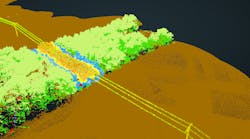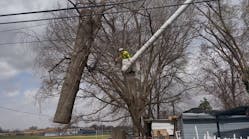Why do we love statistics? Well, they help simplify multifaceted issues in terms that are more easily understood. So often studies use abstract notions that would be better explained in simpler terms, and this is where statistics shine. Recently a whitepaper popped up in the virtual inbox discussing the leading causes of electrical outages, and some of its points were somewhat convoluted. The authors of the whitepaper quoted a prominent government regulatory agency who said, “Trees were generally accepted as the single largest cause of electric power outages.” Whoa, really!
This was a statement to catch attention and it worked. Most people would continue reading it while thinking, what about storms, wildfires, etc? Those events are usually the top causes when it comes to power outages. And further reading supported that, but the trees were an effective hook. The whitepaper’s statistics revealed it was not a simple issue. It reported that the major cause of outages varied between storms, vegetation, wildfires, and combinations of the three.
Having gotten the reader’s attention, the whitepaper shifted to vegetation management as a controllable element for limiting power outages. It also reviewed how today’s utilities were going about vegetation management. They still rely heavily on visual inspections usually performed by a combination of aerial surveys and ground crews to verify what was seen from the air. The takeaway from the paper was utilities and regulators understood the weakness of this method, but were uncomfortable with the advanced technologies behind today’s vegetation management systems.
Errant Vegetation
Intelligent vegetation management methods are proven to be an enormously important tool, but only a few large utilities are taking advantage of this technology on their networks. For those unfamiliar with the term, vegetation management is the control and elimination of unwanted vegetation. And that brings up another important statistical point.
North American utilities are spending between US$6-8 billion annually on maintenance to reduce errant vegetation intrusions on the transmission and distribution networks. Statistically vegetation management is typically the largest segment of a utility’s annual maintenance and operations (O&M) budget. And yet vegetation remains at the top of the list for causes of electricity outages, so what is happening!
It's not complicated, but it seems that way. Keeping it simple, traditional vegetation management practices are heavily reliant on labor intensive processes. Unfortunately, they are only able to cover a fraction of their rights-of-ways (ROW) each year. There are too many miles of transmission and distribution lines needing attention each year for these old-school techniques. After several major blackouts took place, regulators stepped up with mandatory standards and practices, which moved utilities toward more use of technologies to meet their requirements.
Digital Boots
Summarizing, ROWs, and hardware have to be surveyed yearly, along with the removal of intrusive vegetation. The boots on the ground approach can’t keep up with these demands. This is why some remarkable technologies have become the tools of choice. Helicopters, and fixed-wing aircraft quickly provided a method of aerial surveying with arrays of sensors and cameras, but drones are safer and more cost effective.
LiDAR (light detection and ranging) has been brought in to speed up surveying and quickly became the technology of choice. There are other tools like satellites providing twenty-four hour imaging coverage, with a view plane that can zoom from macro to micro. Photogrammetry is also popular especially as asset condition and health were added to the list of characteristics needing to be monitored.
These geospatial and remote-sensing systems give the vegetation manager, engineer, field-crew, etc. the ability to view more terrain faster and with enhanced detail. As the technologies matured, they added more features, but they weren’t user friendly and increased complexity of the process. The vegetation management team had so much big-data and huge amounts of visual imagines to shift through, it became unmanageable.
This is where advancements such as artificial intelligence (AI), machine learning, predictive analytics, cloud storage and computing, with sophisticated software come into play. These technological advancements have been a part of advanced asset management platforms for years. They were designed to make sense of the zettabytes of big-data being produced by every corner of today’s interconnected grid. Well, those techniques are also being applied to vegetation management systems in the form of smarter vegetation management systems.
Data Driven Insights
In 2020, GE Digital introduced what they call a “purpose-built Visual Intelligence Platform for utilities.” It supports vegetation management and asset inspection using modern technology to tame the unwieldy big-data coming from the distribution and transmission corridors. Talking with Brian Hoff, VP of Product Management Analytics and Asset Management at GE Digital, revealed some fascinating facts about this technology.
Hoff started the discussion saying, “The Visual Intelligence Platform (VIP) is able to ingest all the kinds of visual inspection data the utility has. VIP processes that data and produces business intelligence that can be acted upon. The data can be from satellites, LiDAR, photographic, ground-based view, field surveys, or any other source. It doesn’t matter, VIP is not limited by the data the utility has. We like to say, VIP is designed to use the right data for the right use case at the right time for the right cost. That is because no one type of data is the best for every application.”
Hoff continued, “Utilities are under a great deal of pressure to reduce outages and improve the resilience of their power networks. They have focused their efforts on the transmission network, but statistics point out most outages happen on the distribution network, which is a great place to apply VIP for real results. A large utility in the southeastern part of the country recently completed scanning 60,000 miles of their distribution circuits and the data is being used by VIP. VIP is the foundation for that utility’s distribution system’s vegetation management program. It will also be utilized for distribution system’s asset inventory and inspection surveys. The platform is expected to analyze asset conditions and develop targeted action plans.”
Hoff explained, “Machine learning automates the estimation of vegetation growth by comparing how pixels move from one LiDAR survey to the next. This gives vegetation management teams an advantage by identifying tree growth for tree maps used in risk-based assessments for trimming plans. This optimizes tree trimming prioritization, trim volume, and other vegetation remediation tasks. The platform also includes an asset management module for distribution and transmission lines with a focus on hardware, maintenance, and ground clearance analysis. With capabilities such as these, VIP can reduce costs and improve reliability and safety.”
Smarter Management
A report from Utility Analytics Institute reveals there is a growing interest in intelligent vegetation management applications from utilities worldwide. Like most newer technologies these products have taken time to establish themselves. As utilities become comfortable with them, however, they realize the benefits these applications offer can’t be ignored. They have discovered intelligent vegetation management platforms will take the sting out of the combination of vegetation and extreme weather events on power lines.
Recently Hitachi Energy announced the launch of the Hitachi Vegetation Manager. The Hitachi Vegetation Manager combines satellite imagery and deep AI visual analysis to automatically detect and manage vegetation near power lines. It assures all work will only be performed where and when it’s necessary. According to Hitachi Energy’s spokesperson, “It’s the first of its kind in spaceborne resource planning solutions for electric utilities. It’s part of the broader visual Hitachi analytics suite, Lumada Inspection Insights, which helps slow-to-evolve utilities adopt AI-powered technology.”
National Grid Partners are partnering with AiDash to deploy AiDash’s Intelligent Vegetation Management system on National Grid’s electric lines. It’s an end-to-end satellite-powered platform that uses AI algorithms to monitor and analyze what is taking place along the electric lines vegetation wise. Satellite data provides actionable information after being processed by AiDash’s software. From there it can be used with predictive analytics to identify future risks due to vegetation.
Last year IBM launched their AI-driven software for their cloud-based Environmental Intelligence Suite. IBM said, the suite contains applications that predict how the environment will impact a company’s assets, employees, and customers. For something like vegetation management, the platform assesses the state of the vegetation across the enterprise’s service territory. With proactive management, it can prioritize tasks, predict risks, and assist with decision making.
These smarter vegetation management systems have been developed to reduce the number of outages identified using data-driven analytics, but utilities need to use these tools to be effective. Traditional vegetation management systems identify the majority of vegetation needing attention, but they often miss what’s known as “trouble trees.” These are the trees located on and off the ROW that “could” contact power lines. AI-powered vegetation management platforms look for trees with that signature and quickly identify them. Utilities using this technology can remove those problem trees while saving money and improving reliability. It gives them a big edge over those utilities stuck in the 20th century.


